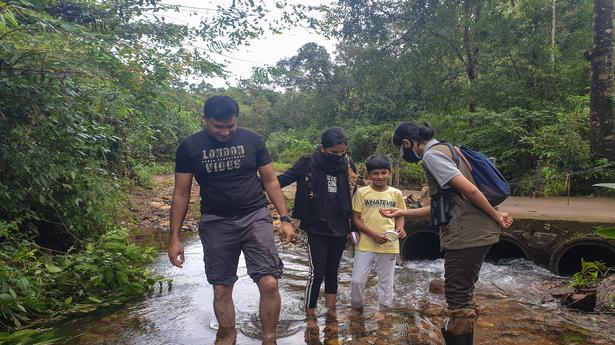
Nature guides introduce the flora and fauna of the Western and Eastern Ghats to trekkers and visitors
The Hindu
A surge in monsoon travel, fuelled by Indians focussing on the great outdoors this year, has fuelled a rise in imaginative treks, where guides teach you everything from photographing amphibians to counting stars
As the monsoon embraces the Western Ghats, the forests come alive. Noisy frogs call their mates while crickets, cicadas and grasshoppers compose the background score. Wind whistles through leaves as forest streams gurgle with renewed vigour. Bats, flying foxes and gliding frogs silently swoop through the canopy, while night moths glide between the foliage.
The ideal time to meet these denizens of the wild in their habitat is when the rain-soaked hills are carpeted in green. As monsoon travel regains pace after a tough couple of years, Nature walks, led by guides who focus on birding, herping, mammals and local flora are getting increasingly popular.
In the Western Ghats, David Raju, general manager of Wayanad Lodge, CGH Earth Wayanad and a veteran naturalist, points out that there are certain species, both flora and fauna, endemic to the region. “We introduce visitors to bird, frog and snake species in addition to butterflies, moths and mammals.” Malabar grey hornbill, Grey-headed bulbul, Nilgiri wood pigeon, Flame-throated bulbul, Malabar gliding frog, Waterdrop frog, Winged gliding frog, Indian rock python and Malabar vine snake are some of the usually spotted species.
Nature guides also connect the tourists to local communities, resulting in memorable travel with a positive impact. Thorthey Gooden, a Toda Nature guide in the Nilgiris, introduces tourist groups to the flora and fauna around his village by narrating stories about the plants, mountains and the Toda way of life. “I tell how in the past the monsoon was so heavy, our buffaloes, which are left outdoors, would have fungi growing on their horns. But not any longer,” he says, adding that he also explains how their ancestors were food gatherers. “I show them the berries and plants we consume as the Todas are vegetarians.”
R Yeshwanth Kumar, a Nature guide working with a resort near Udhagamandalam, says that in the Nilgiris, leopards and an occasional tiger can also be spotted sunning on rocks or in the vicinity of villages during the rains, in addition to sambar, barking deer and lion-tailed macaques.
In Gudalur in Tamil Nadu, K Satheeshan says he notices that visitors from North India in particular, “are enchanted by the numerous waterfalls, streams and rivulets that criss-cross the hills. If we are lucky, we see herds of elephants and bisons in the evening.”
Sumit Sharat Kamble, a naturalist in Machan Plantation in Sakleshpur district, Karnataka, says he has noticed an increasing number of visitors from the city ever since pandemic restrictions began to ease. Prior to his stint in Karnataka, Sumit used to take visitors on walks in Matheran, Amboli Ghat and Lonavla in Maharashtra. At this time of the year, it is the breeding season for birds like Indian pitha, Malabar whistling thrush, Oriental Dwarf kingfisher and Sahyadri sunbird.

“Writing, in general, is a very solitary process,” says Yauvanika Chopra, Associate Director at The New India Foundation (NIF), which, earlier this year, announced the 12th edition of its NIF Book Fellowships for research and scholarship about Indian history after Independence. While authors, in general, are built for it, it can still get very lonely, says Chopra, pointing out that the fellowship’s community support is as valuable as the monetary benefits it offers. “There is a solid community of NIF fellows, trustees, language experts, jury members, all of whom are incredibly competent,” she says. “They really help make authors feel supported from manuscript to publication, so you never feel like you’re struggling through isolation.”

Several principals of government and private schools in Delhi on Tuesday said the Directorate of Education (DoE) circular from a day earlier, directing schools to conduct classes in ‘hybrid’ mode, had caused confusion regarding day-to-day operations as they did not know how many students would return to school from Wednesday and how would teachers instruct in two modes — online and in person — at once. The DoE circular on Monday had also stated that the option to “exercise online mode of education, wherever available, shall vest with the students and their guardians”. Several schoolteachers also expressed confusion regarding the DoE order. A government schoolteacher said he was unsure of how to cope with the resumption of physical classes, given that the order directing government offices to ensure that 50% of the employees work from home is still in place. On Monday, the Commission for Air Quality Management in the National Capital Region and Adjoining Areas (CAQM) had, on the orders of the Supreme Court, directed schools in Delhi-NCR to shift classes to the hybrid mode, following which the DoE had issued the circular. The court had urged the Centre’s pollution watchdog to consider restarting physical classes due to many students missing out on the mid-day meals and lacking the necessary means to attend classes online. The CAQM had, on November 20, asked schools in Delhi-NCR to shift to the online mode of teaching.









